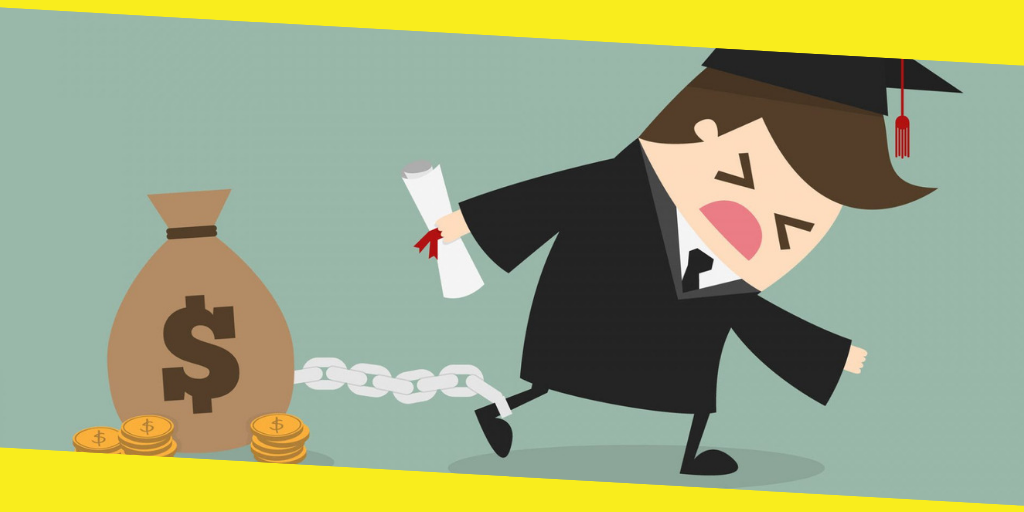The Burden of Student Loans on American Millennials

With the American Student loan debt standing at $1.56 trillion spread out among 44.7 million borrowers, it makes it the second highest consumer debt after mortgages. Worse than this high rate is the adverse effects the debt has on young people and the entire economy.
Statistics state that by 2023, nearly 40% of borrowers may default on their student loans. Why is the default rate so high and what causes it?
According to John Thornton, students are often excited with the promise of a bright future that university education brings. They are convinced that college education shapes them into people capable of developing their destiny, which is true.
However, nothing is mentioned on the incapacitation that can result from taking a student debt. Eager to “gain control of their destiny” they apply for a student loan. When it’s time for repayment, they find themselves chained by the huge debt which then prevents any financial growth.
The graduate’s high expectation of a beautiful life having attained a college degree turns into a huge disappointment. Instead of a life of financial freedom, the student debt dictates their life. It becomes a determining factor in decisions such as when they can buy a house, what they can spend, or the kind of vacation they can have.
There are several negative effects that a student loan can have on a young adult’s life.
Contents
ToggleLack of Freedom in Career Choice
With the burden of a student loan on the shoulders, most borrowers are less likely to choose a career out of passion or get into entrepreneurship. The main factor they consider before taking a job is income. As long as it is capable of taking care of their needs and covering the loan repayment, job satisfaction does not matter. So much for the American dream.
Poor Retirement Plan
A study by the Student Debt Crisis in partnership with Summer indicated that most millennials are not saving for retirement. Too much financial obligation leads to an inability to build savings or contribute to a retirement plan. On average, most people with student loans have saved less than $1,000 while 80% are incapable of saving for retirement.
Delayed Home Ownership
With the substantial burden of a student loan, it comes as no surprise that the rate of home ownership among the youth has dropped. The study by Student Debt Crises also indicated that 56% of the borrowers are unable to buy a home and 19% delay getting married.
Risk of Poor Credit Score
Sometimes, the inevitable happens, and a borrower fails to repay their student loan. Skipping several months of payment can negatively affect the individual’s credit score which puts them at risk of lenders denying them credit though there are always alternative available for short term fix , check out realistic loans so find some helpful lenders giving credits to poor credit as well .
A Major Stress Factor
The inability to make progress in life, plan adequately for the future, and follow one’s dreams is a major cause of dissatisfaction. For some, it has resulted in mental health problems such as depression.
Here are the reasons why student loans have turned into a nightmare for many young adults.
Inadequate Income
The unemployment rate in America decreased to 3.9% in 2018 from 4.4% in 2017. However, with little wage growth and high debt, millennials are less likely to achieve as much financial prosperity as their predecessors – the baby boomers and generation Xers. They are earning much less despite being more educated.
The student loan is given with the expectation of repayment once the student finds a job. The income, however, should be high enough to cover the debt and leave extra for the individual’s personal development. It has not been the case. Graduates are using a large portion of their wages to pay their student debt and are still left with a massive debt balance.
So of what use is the student loan as a means to improve one’s life if you spend half of your career life paying it back?
Some young adults remain unemployed even after attaining a college degree. Unemployment mainly hits minority groups. It has been proven by research which indicates that blacks and Hispanics have a high unemployment rate even with the same education level as their peers. Unemployment results in default of the student loan.
Increased Cost of Education
The cost of college education has been skyrocketing since the 80s. An analysis of the public college tuition paid by students in the 1987-1988 school year shows a 213% increase in the 2017-2018 school year. The same case applies to private nonprofit four-year institutions which show a 129% increase in tuition fees in the same 10-year period.
There is an increase in college fees leading to increased student debt, and yet the wages grow at a painfully slow rate. While college debt was advantageous ten years ago, it has become a burden today. Young graduates end up starting life with debt that their meager salary can hardly cover.
The rising cost of education is owed to the fact that the government has reduced its support for institutions of higher education transferring the burden of cost to the students. There has also been an increase in student enrollment leading to higher costs such as hiring faculty members.
So this raises the question, should the cost of running a public educational institution be laid on the students?
Increased Cost of Living
Students take a loan with the hope of acquiring an education that can lead to a stable income. It does happen in most cases. However, the cost of living is so high topped up with the student debt, such that many borrowers live pay check to pay check, incapable of achieving financial freedom.
The cost of living for the millennials is significantly higher than that of its predecessors. The Federal Reserve Bank of St. Louis found that having more debts than assets, millennials in 2016 have a net worth averaging $90,000 which is $40,000 less than what Generation X households were worth 15 years ago.
The high cost of living can be attributed to the increased cost of fuel, increased prices of food, and the high cost of insurance not to mention the cost of buying a house which has skyrocketed. These increased costs thus outweigh a decent income Add the high student loan, and it all becomes a cycle where money is out of your pocket as soon as it is in.
In conclusion, student loans are not entirely evil. It has helped thousands achieve college education that could otherwise just been a dream. People educated through student loans have built many giant companies that are significant contributors to the American economy.
However, the loans have also been a major cause of stress for others resulting in a high default rate. These borrowers end up taking jobs they hate for the money. They delay making major life decisions due to the debt burden and are unable to save and develop their lives.
Most of these borrowers who experience problems in repayment take the loans with little information on its future implications. New borrowers should be thoroughly advised for them to make informed decisions. The advice can prompt them to take courses that lead to high-income careers or finance their education through alternative methods such as part-time jobs.
Information is power, as long as one is fully aware of what they are getting into by taking a student loan, they can make better plans, and reap its benefits.
Recommended For You
4 Jobs You Can Plan Around Your Kids
Most Inside
Most Inside offers high-quality recommendations and valuable updates to enhance all aspects of your life, providing premium guidance and enriching experiences.




